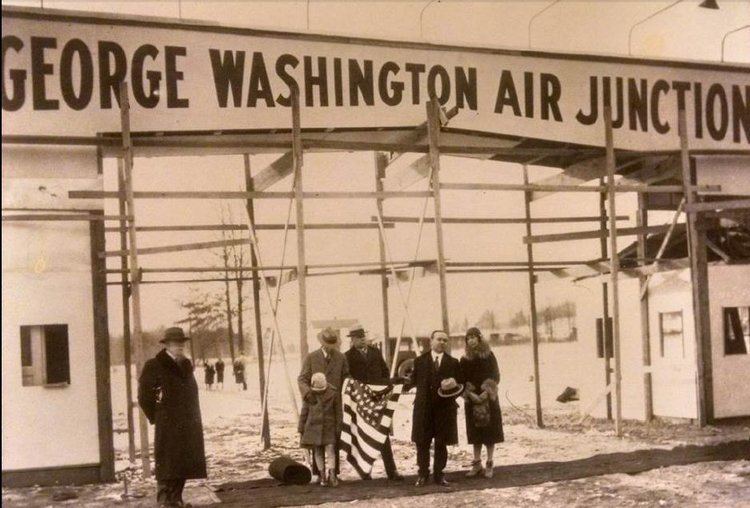 | ||
The George Washington Air Junction was a proposed airport for Fairfax County, Virginia. It was designed to be the world's largest airport, larger than those of New York, London, Berlin, Paris, Chicago, and Philadelphia combined. It was to have the world's longest runways and facilities to accommodate dirigible airships like the Zeppelin. It never opened, and the land was eventually seized.
Contents
Background
The George Washington Air Junction airport was a project of entrepreneur Henry Woodhouse. He was an aviation enthusiast and represented himself as president of the Aerial League of America, although there is no evidence that such an entity existed. He believed that dirigibles were the aircraft of the future, so as a real estate investor, and entrepreneur he started planning in 1919 to buy up farms in the Hybla Valley of Fairfax County, Virginia (USA). He bought some 1,500-2,000 acres (600-800 ha) in the 1920s from different land owners. His idea was to turn the dairy farms into the world's largest airport, with the longest runways anywhere in the world. The airport was to be an international base for all kinds of aircraft.
Woodhouse called his future intended airport the "George Washington Air Junction" because it was on land once owned by George Washington. He was hoping to make the land Washington, D.C.’s commercial national airport. He envisioned the airport as the largest in the world, complete with fields for Zeppelin flights to land after they had crossed the Atlantic from Europe. Woodhouse thought that the dirigibles had potential as aircraft for the future. He developed plans in 1929 to build a runway 7,500 feet (2,300 m) long—the world's longest.
Description
The Herald Times wrote up an article in 1938 on the Washington Air Junction site, complete with a high altitude picture taken from an airplane looking south that was illustrated with the intended layout. The picture showed a plan for three of the world's largest runways, a hangar, and an administration building. It claimed that Hybla Valley was the largest airport site available near Washington, D.C. It explained that the layout geography of the 3,800 acres (1,500 ha) of land three miles (5 km) south of the city of Alexandria was as flat as a tabletop. It further explained that it was near one of the busiest highways in northeastern United States. The idea was planted in this newspaper article that this could become larger than any airport in the world.
The earliest indication of the George Washington Air Junction was a 1929 photo taken from an airplane by pilot Orville Blake. It showed three runways which had been cleared on the airport property. They were located just south of a dirt road that became Lockheed Boulevard in Hybla Valley, Virginia. The Washington Air Junction airport was depicted on a 1930 Standard Oil Company Virginia road map as being directly east of Groveton about a mile northwest of the Hybla Valley Airport and about two miles southwest from the Beacon Field Airport. The area was Zeppelin's manager Hugo Eckener's choice for an American terminal for his dirigible airships.
History
The George Washington Air Junction airport was introduced with much fanfare by Woodhouse, the main owner of the airport. In May 1929 for a publicity stunt there was a gathering of George Washington's descendants at the christening ceremonies of the opening of the airport. A picture was taken of them, that was promoted through various newspapers nationwide, next to a replica of the first passenger balloon that flew in the Western Hemisphere that was watched by Washington himself. The land for the anticipated largest airport in the world was once part of George Washington's estate and near Mt. Vernon.
The airport was designed to be larger than any in the world, bigger in size than the New York, London, Berlin, Paris, Chicago, and Philadelphia ones put together. Woodhouse claimed it would eventually become the combined size of the airports of Croydon in London, Le Bourget in Paris, Tempelhof in Berlin, Roosevelt Field in New York, Chicago's Air Park, and Boston's Jeffery Field. However, the airport never did develop as intended and a 1949 picture taken from an airplane showed no evidence of the three world's longest runways which had been illustrated in earlier depictions.
Demise
The George Washington Air Junction airport never came into operation and no airlines ever operated out of it. Woodhouse's dream of the world's largest airport never came to fruition in spite of all the planning and preparation he did. The airport never showed up on any government publications of official airports. It is listed in the Abandoned & Little-Known Airfields online database for southeastern Fairfax County, Virginia. Woodhouse eventually lost all the property during the Great Depression of the 1930s through a combination of lawsuits, defaults, back taxes and foreclosures.
A real estate holding company had taken possession of the property since it was never developed as an airport. It then leased parcels to dairy farmers. The federal government purchased the acreage for $60,000 in 1941. The Bureau of Public Roads used the site between 1943 and 1953 to test road surfaces. The U.S. Naval Research Laboratory took over in 1954 for communications research. In 1955, the Virginia National Guard used the land for an antiaircraft base. Fairfax County purchased the site for a dollar in 1975 and it was eventually developed into the Huntley Meadows Park.
